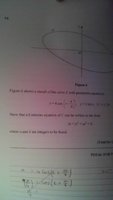You are using an out of date browser. It may not display this or other websites correctly.
You should upgrade or use an alternative browser.
You should upgrade or use an alternative browser.
Converting Trig Parametric equations for ellipse to cartesian equation
- Thread starter H.Bisho18
- Start date
Thanks for the quick reply, and no im not sure how to do that.Hello, and welcome to FMH!
Can you verify that:
[MATH]x+y=2\sqrt{3}\cos(t)[/MATH] ?
Is it just sub to 2 trigs in and simplify it down?
D
Deleted member 4993
Guest
Do you know a general equation (in cartesian co-ordinates) for an oblique ellipse?HI
I have this parametric equation problem.
View attachment 11662
and im not sure what to do since its cos(t+pie/4) and sin(t). Normally i would rearrange and use the sin^2 + cos^2 =1 identity but that wont work here.
I also tried using the double angle cos rules but i got lost from there.
thanks for any help
Do you know a general equation (in cartesian co-ordinates) for an oblique ellipse?
I dont. I just know the dy/dx=dy/dt * dt/x and the using trig identities to get the cartesian
- Joined
- Nov 24, 2012
- Messages
- 3,021
Thanks for the quick reply, and no im not sure how to do that.
Is it just sub to 2 trigs in and simplify it down?
Using the angle-sum identity for cosine, can you rewrite:
[MATH]4\cos\left(t+\frac{\pi}{6}\right)[/MATH] ?
Yep 4(cos(t)cos(π/6) -sin(t)sin(π/6))Using the angle-sum identity for cosine, can you rewrite:
[MATH]4\cos\left(t+\frac{\pi}{6}\right)[/MATH] ?
i got that then tried to rearrange the y=2sin(t) for t and sub it in. but i didnt get anywhere
- Joined
- Nov 24, 2012
- Messages
- 3,021
Yep 4(cos(t)cos(π/6) -sin(t)sin(π/6))
i got that then tried to rearrange the y=2sin(t) for t and sub it in. but i didnt get anywhere
The angle [MATH]\frac{\pi}{6}[/MATH] is one of our "special angles" for which we know the value of the trig. functions:
[MATH]\cos\left(\frac{\pi}{6}\right)=\frac{\sqrt{3}}{2}[/MATH]
[MATH]\sin\left(\frac{\pi}{6}\right)=\frac{1}{2}[/MATH]
Using these, we then find:
[MATH]4\cos\left(t+\frac{\pi}{6}\right)=4\left(\frac{\sqrt{3}}{2}\cos(t)-\frac{1}{2}\sin(t)\right)=2\sqrt{3}\cos(t)-2\sin(t)[/MATH]
And so:
[MATH]x+y=\left(2\sqrt{3}\cos(t)-2\sin(t)\right)+\left(2\sin(t)\right)=2\sqrt{3}\cos(t)[/MATH]
So now, consider the sum:
[MATH](x+y)^2+ay^2[/MATH]
Can you see that this may be written as:
[MATH](x+y)^2+ay^2=12\cos^2(t)+4a\sin^2(t)[/MATH] ?
ah yes that makes alot of sense now. thank you so muchThe angle [MATH]\frac{\pi}{6}[/MATH] is one of our "special angles" for which we know the value of the trig. functions:
[MATH]\cos\left(\frac{\pi}{6}\right)=\frac{\sqrt{3}}{2}[/MATH]
[MATH]\sin\left(\frac{\pi}{6}\right)=\frac{1}{2}[/MATH]
Using these, we then find:
[MATH]4\cos\left(t+\frac{\pi}{6}\right)=4\left(\frac{\sqrt{3}}{2}\cos(t)-\frac{1}{2}\sin(t)\right)=2\sqrt{3}\cos(t)-2\sin(t)[/MATH]
And so:
[MATH]x+y=\left(2\sqrt{3}\cos(t)-2\sin(t)\right)+\left(2\sin(t)\right)=2\sqrt{3}\cos(t)[/MATH]
So now, consider the sum:
[MATH](x+y)^2+ay^2[/MATH]
Can you see that this may be written as:
[MATH](x+y)^2+ay^2=12\cos^2(t)+4a\sin^2(t)[/MATH] ?

